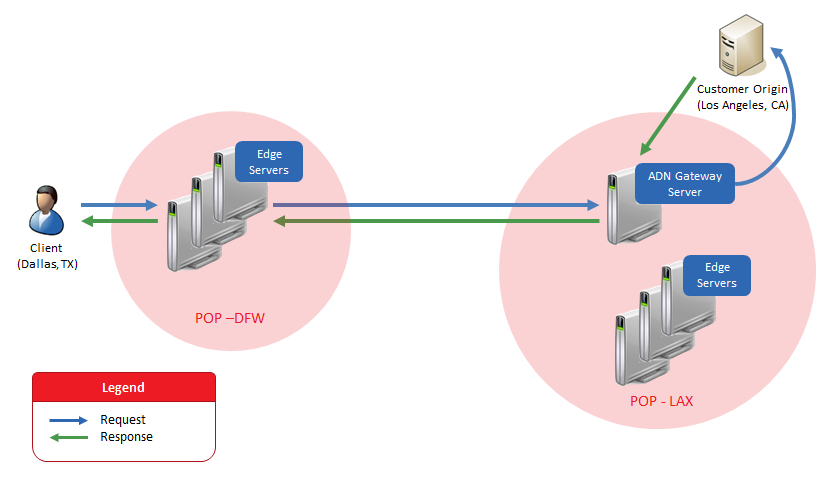HTTP content may be served through our ADN, HTTP Large, or HTTP Small platforms. Our ADN platform is designed to serve dynamic content, while the HTTP Large & HTTP Small platforms are designed to serve static content. This difference affects the workflow through which content is delivered.
HTTP Large and HTTP Small
Serving content through the HTTP LargeThis platform has been optimized to cache and deliver static content (e.g., HTML, CSS, JavaScript, ISO, multimedia, and software downloads, etc.) over HTTP or HTTPS. or the HTTP SmallLegacy. If you are currently serving traffic over this platform, then you may continue to do so. However, we recommend that you serve your traffic over our more robust HTTP Large platform. platform allows our CDN network to transmit your content in a more efficient manner to your customers. Our network has been optimized to allow data to quickly travel between where it is stored and the point-of-presence (POPIdentifies a location on our network through which users can request and receive content.) closest to the requesterRefers to the user that requested content.. Additionally, a copy of the requested content may be stored on that POP. This process is known as caching. Once content has been cached, subsequent requests for that content from that region may be delivered directly from that POP. This eliminates the need to retrieve the data from the origin serverRefers to the server(s) where content served via the CDN is stored. There are two types of origin servers, which are CDN and customer origin servers. All requests that cannot be fulfilled directly by an edge server are forwarded to an origin server. For example, a request for content that has not been previously cached is forwarded from an edge server to an origin server..
The process through which requests flow through our network is illustrated below.

Application Delivery Network (ADN)
The ADN platform is designed to quickly deliver dynamic data from a customer origin server to your users. It is able to do so through the following techniques:
| Technique | Description |
|---|---|
|
Edge Data Delivery |
The ADN platform is designed to reduce the distance between the requester and the edge of our network. This allows data to travel over our fast and efficient network instead of suboptimal networks. |
|
Server Communication Optimizations |
Our network leverages transit and peering links to ensure optimal data delivery speed within our network. Since your customer origin server is outside our network, data will need to travel through sub-optimal networks. In order to reduce the distance that data must travel on sub-optimal networks, we have established an intermediary set of servers through which all requests to your customer origin server must flow. These servers are known as ADN gateway servers. The use of ADN gateway servers ensures that an optimal network route is used to communicate between our network and your customer origin server. |
|
RFC-compliant Protocol Optimizations |
Our network has been fine-tuned to ensure data communication efficiency through the use of RFC-compliant protocol optimizations. These optimizations do not require additional configuration or consideration on your end. |
|
Disabling Content Caching |
By default, the caching of content is disabled on the ADN platform. This allows our edge servers to focus on processing requests. Caching content does not typically make sense for the ADN platform, since it is designed to speed up data delivery for content that does not benefit from our caching technology. |
Basic Request Flow
An overview of how content is delivered from a customer origin server to a user is illustrated below.

| Phase | Description | |
|---|---|---|
|
1 |
Request |
This data delivery process starts with a user's request for content. This request is directed to the POP closest to the user. |
|
2 |
Optimal Routing |
An edge server in that POP will forward the request to the ADN gateway server that can provide optimal communication to the corresponding customer origin server. |
|
3 |
Request Forwarding |
The ADN gateway server will forward the request to the customer origin server. |
|
4 |
Response |
The customer origin server will provide a response to the user via anADN gateway server and the edge server in communication with the user. |
A slightly more concrete example is provided below. Notice that the response flows back through the . Minimizing data delivery over is one way in which ADN ensures optimal data delivery performance.

More Information
- Request
- Frequently Asked Questions - ADN
- Frequently Asked Questions - Content Delivery
- Frequently Asked Questions - Cache Management
Edgecast CDN